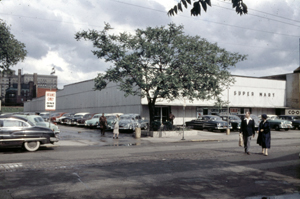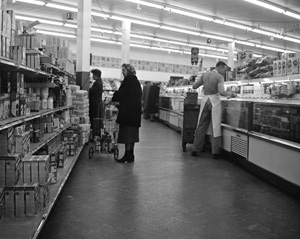Market history
Historian Tracey Deutsch, AB'90, studies how food consumption has evolved in the 20th century.
By Ruth E. Kott, AM'07
Photography from Special Collections Research Center, University of Chicago Library
When Tracey Deutsch, AB'90, was growing up in Chicago's West Rogers Park neighborhood, her mother took her grocery shopping almost every Saturday afternoon. "On those outings, I saw everything," she remembers, "from fights at the whitefish counter…to discussions between [my mother] and my grandmother about family dynamics and upcoming family dinners." Even as a child, she noticed race and class tensions playing out: "People look in other people's baskets and judge what they're buying and why they're buying it. Or you can tell when you check out who is paying with food stamps and who is not."

The Hyde Park Co-Op's 2008 closing, says Deutsch, marks a move toward private ownership.
Deutsch—an assistant professor of history at the University of Minnesota with a new book out on the history of supermarkets—paints a picture of stores alive with social interactions and struggles that often contradict the standardized model supermarkets are known for. The tensions lie underneath the surface of shelves stocked with canned or processed food, regulated for quality and cost, and manned by carefully trained employees. Name-brand, organic (and, therefore, more expensive) boxes of bran flakes compete with bags of cheaper, store-brand, sugar-coated flakes in the cereal aisles, leading consumers to make their decisions based on cost, health, or taste.
The deli counter's "pick a number" system is another method supermarkets have designed to streamline service. But even there, Deutsch recalls, fights can break out. On one childhood trip to the grocery store, when there was a big sale at the fish counter, her mother left her in line with the number to wait while she went to grab something else—"there was a really, really long line," says Deutsch. She liked the responsibility, until the women in front of her started arguing—"I suspect it had to do with the size of the fish and perceptions about its quality," she says. "Then they started saying, 'Why is there a kid here?'" Unintentionally, nine-year-old Deutsch was dragged into supermarket social politics. "That was exciting to me. It was this sum total of realizing how much work went into grocery shopping and all the social systems, and that those things all mattered structurally to the way that businesses ran."
She may not have been able to phrase her fascination that way at age nine, but Deutsch's 2010 book, Building a Housewife's Paradise: Gender, Politics, and American Grocery Stores in the Twentieth Century (University of North Carolina Press), connects consumer culture and capitalism with narratives of gender, race, and class across more than four decades. It also explores the structural changes that created the supermarkets we know today. Looking at the period from the end of World War I to the end of World War II, Deutsch traces how cultural ideas about what women wanted affected grocery-store policy—and how they reacted to changes in food shopping.
A historian who studies women and capitalism, Deutsch noticed while working toward her PhD at the University of Wisconsin that there was a gap in the literature. "Most of the work about women, gender, and consumption ended in 1920 or started in 1950." But, she argues, "the kind of consumer culture that we're so comfortable with had its roots in that time period." Many of the key shifts happened not with department stores, which she originally conceived as her research topic. Instead, "it became really clear to me that the important structural changes in this time happened in grocery."
She limits the scope of her book's study, looking at how supermarkets arrived in Chicago, instead of at a national level. "I really wanted to study the way that [business and government] policy mattered on the ground, and that meant focusing in on a place." The local focus also allowed her to delve into Chicago-specific class and race issues. "When you look at people at the moment of food shopping," Deutsch argues, race, class, and gender aren't divisible.
In the first decades of the 20th century, small, independent stores and markets were the norm, and time-consuming negotiation was the major method for determining an item's cost. Grocers expected that "women customers would demand significant authority over the terms of purchase," Deutsch writes in her book, and require individual attention. And because food was a daily necessity, women prided themselves on being able to cut costs. Those who didn't do their own food shopping in the market—by ordering their groceries by phone, for example—were considered lazy, or even incompetent, by other women, who assumed that they got lesser-quality food if they didn't go to the store themselves. The shopping was hard work, writes Deutsch, and included haggling and "busy jockeying for position."
When large chain stores started popping up in Chicago in the 1920s, the owners primarily targeted the middle-class and certain immigrant communities, avoiding both very wealthy and very poor neighborhoods. Rather, they opened stores in neighborhoods where they thought women would be budget-minded, forward thinking, and independent, consumers who would want to shop in self-service grocery stores and have complete control over their food-buying. But because customers lost control over pricing (among other complaints), some women resisted the changes, leading protests over consumer rights and chain stores' high costs and labor violations throughout the 1930s and '40s.

Gaining popularity in the '30s, co-ops (like Hyde Park's, seen here in the '50s) were a response to chains.
Food co-ops became popular in the 1930s, another response to big supermarket chains, which sometimes sold products that were of questionable quality and engaged in misleading advertising. As members-owned grocery stores, writes Deutsch, these co-ops were considered "a more democratic version of mass retailing." While getting her master's degree at New York University, Deutsch started her research with the Hyde Park Co-Op, then located at its 55th Street and South Lake Park Avenue location, mainly because she was familiar with it.
"I did shop there pretty often" as a College student, she says, even though she couldn't always afford it. It was also a longstanding co-op, and, when she was doing research, its members "were very generous and gave me access" to all kinds of records. In Deutsch's experience, co-ops were more open with their records than large chains. "Businesses tend not to be historically minded in the way that historians are," she points out. Adding to the problem was that many the stores she researched for her book—like National Tea Company, started in Chicago in 1899—"had gone out of business, so their records had been sent off to whatever corporations had bought these stores, and they weren't a priority for that company."
The records of the Hyde Park Co-Op—which opened in 1932 and closed in 2008—now reside at the Chicago History Museum and in the University of Chicago's Special Collections Research Center. It's not the only store of its kind to have failed, but many have failed recently. "I think that it is a marker of an increased move toward private ownership," says Deutsch. "But I also think that it represents what has been a long-term problem for consumer co-ops, which is having enough capital for expansion." The issue, she says, was not so much that people weren't shopping there, but that, when the Hyde Park Co-Op expanded in the late 1990s and early 2000s, opening a 47th Street location, it no longer had enough capital to support both stores. A lack of capital has long "been a problem for co-ops," she says. "That was a problem for co-ops in the '30s."
Because many supermarkets didn't open stores in poor neighborhoods—and those that did open there quickly left after the 1968 riots following Martin Luther King Jr.'s assassination—those areas in Chicago are at a greater disadvantage now, Deutsch says, because they lack access to fresh food. In the early 20th century poor neighborhoods now classified as "food deserts," places that include much of the South Side, were "teeming with food." Peddlers walked down the street daily with wagons full of fresh fruits and vegetables. There were also small stores that stayed open late and sold on credit, to accommodate people with different schedules and economic situations.
Regardless of class, many shoppers now, as then, piece together their food from different sources. "Food shopping isn't something you do once a week and you're done," she says—a reality unchanged by the dominant model of one-stop shopping for large quantities of goods (exemplified by supermarkets). It just doesn't work like that: "You get paid, so you can do a bigger shopping trip that day, but then you run out of stuff during the week and you don't have time to go somewhere else." Or you need something when the stores are closed, or you forgot an ingredient so you need to go to the nearest convenience store to pick it up. As Deutsch argues in her conclusion, food shopping is still hard work.
